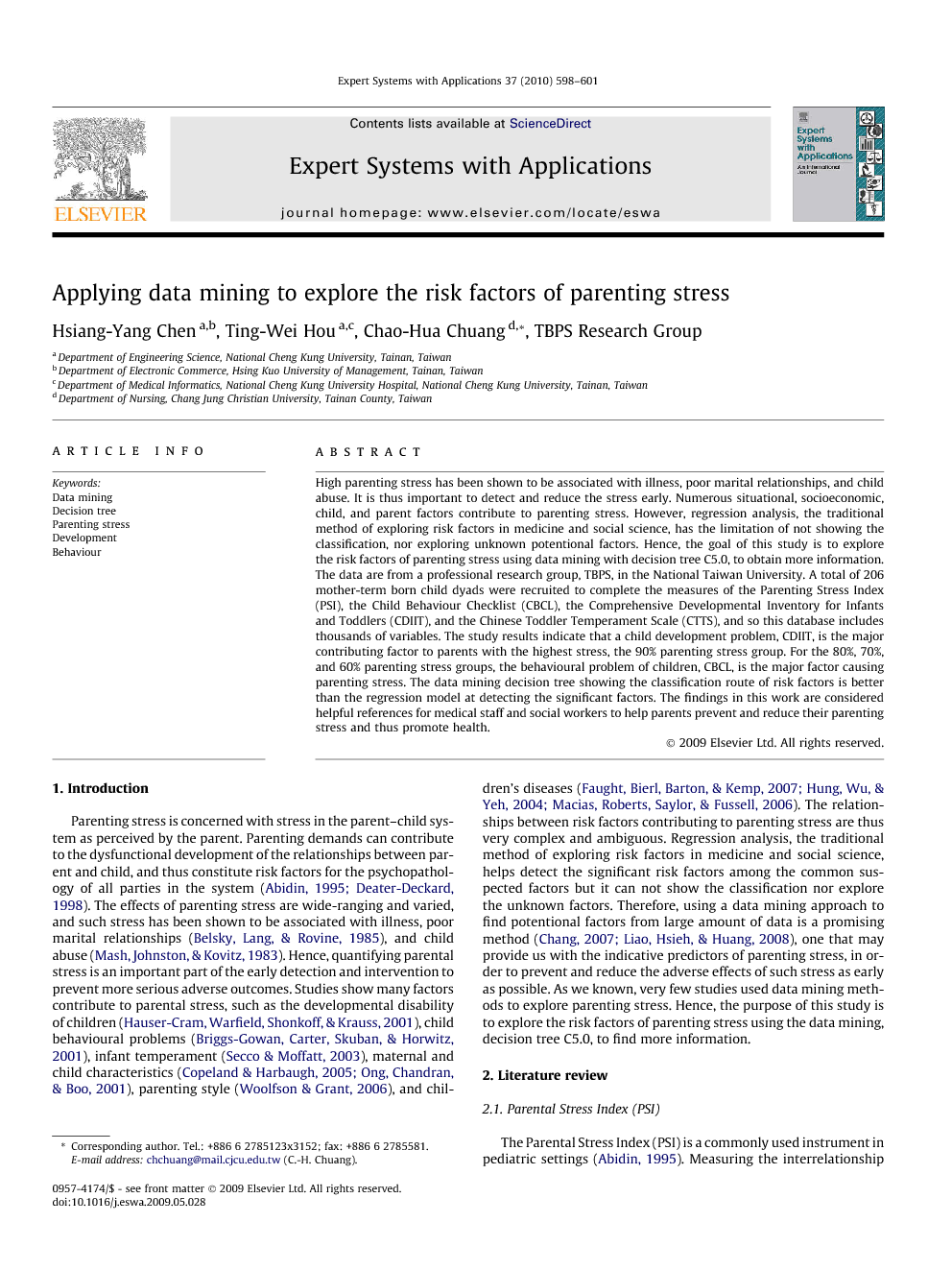High parenting stress has been shown to be associated with illness, poor marital relationships, and child abuse. It is thus important to detect and reduce the stress early. Numerous situational, socioeconomic, child, and parent factors contribute to parenting stress. However, regression analysis, the traditional method of exploring risk factors in medicine and social science, has the limitation of not showing the classification, nor exploring unknown potentional factors. Hence, the goal of this study is to explore the risk factors of parenting stress using data mining with decision tree C5.0, to obtain more information. The data are from a professional research group, TBPS, in the National Taiwan University. A total of 206 mother-term born child dyads were recruited to complete the measures of the Parenting Stress Index (PSI), the Child Behaviour Checklist (CBCL), the Comprehensive Developmental Inventory for Infants and Toddlers (CDIIT), and the Chinese Toddler Temperament Scale (CTTS), and so this database includes thousands of variables. The study results indicate that a child development problem, CDIIT, is the major contributing factor to parents with the highest stress, the 90% parenting stress group. For the 80%, 70%, and 60% parenting stress groups, the behavioural problem of children, CBCL, is the major factor causing parenting stress. The data mining decision tree showing the classification route of risk factors is better than the regression model at detecting the significant factors. The findings in this work are considered helpful references for medical staff and social workers to help parents prevent and reduce their parenting stress and thus promote health
Parenting stress is concerned with stress in the parent–child system as perceived by the parent. Parenting demands can contribute to the dysfunctional development of the relationships between parent and child, and thus constitute risk factors for the psychopathology of all parties in the system (Abidin, 1995 and Deater-Deckard, 1998). The effects of parenting stress are wide-ranging and varied, and such stress has been shown to be associated with illness, poor marital relationships (Belsky, Lang, & Rovine, 1985), and child abuse (Mash, Johnston, & Kovitz, 1983). Hence, quantifying parental stress is an important part of the early detection and intervention to prevent more serious adverse outcomes. Studies show many factors contribute to parental stress, such as the developmental disability of children (Hauser-Cram, Warfield, Shonkoff, & Krauss, 2001), child behavioural problems (Briggs-Gowan, Carter, Skuban, & Horwitz, 2001), infant temperament (Secco & Moffatt, 2003), maternal and child characteristics (Copeland and Harbaugh, 2005 and Ong et al., 2001), parenting style (Woolfson & Grant, 2006), and children’s diseases (Faught et al., 2007, Hung et al., 2004 and Macias et al., 2006). The relationships between risk factors contributing to parenting stress are thus very complex and ambiguous. Regression analysis, the traditional method of exploring risk factors in medicine and social science, helps detect the significant risk factors among the common suspected factors but it can not show the classification nor explore the unknown factors. Therefore, using a data mining approach to find potentional factors from large amount of data is a promising method (Chang, 2007 and Liao et al., 2008), one that may provide us with the indicative predictors of parenting stress, in order to prevent and reduce the adverse effects of such stress as early as possible. As we known, very few studies used data mining methods to explore parenting stress. Hence, the purpose of this study is to explore the risk factors of parenting stress using the data mining, decision tree C5.0, to find more information.
The quality of interaction between children and parents is important, and it will affect the health of all parties in the relationship. Initially, parenting stress is an important indicator of the quality of such interactions. To date, there are few studies that explore parenting stress using data mining methods, which provide more information and classification than regression models to explore the relevant risk factors. Hence, our study conducted data mining to explore the factors related to increased parenting stress, and the child’s development and behaviour were found to be highly significant. Our results show the following clinical classifications that for 90% parenting stress there is one group in which the CDIIT scores are equal or less then 85, the mothers are without a job, and the children are second birth order; the other group has CDIIT scores of equal or less then 85, mothers with a job, fathers with a university or higher education, male children, family income per year over 1,000,000 NT$, and mothers’ age over 34. Hence, the findings of our study will be useful for parents themselves, medical staff, social workers, or public health workers in attempting to detect high risk parent–child dyads and provide intervention early to reduce and prevent parenting stress


